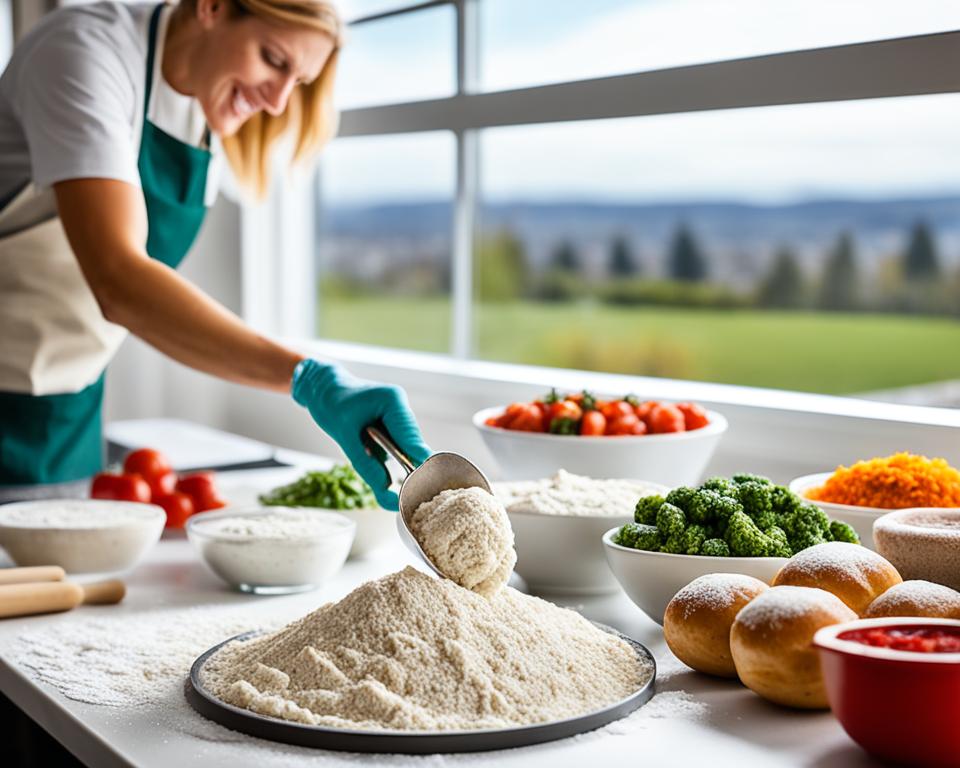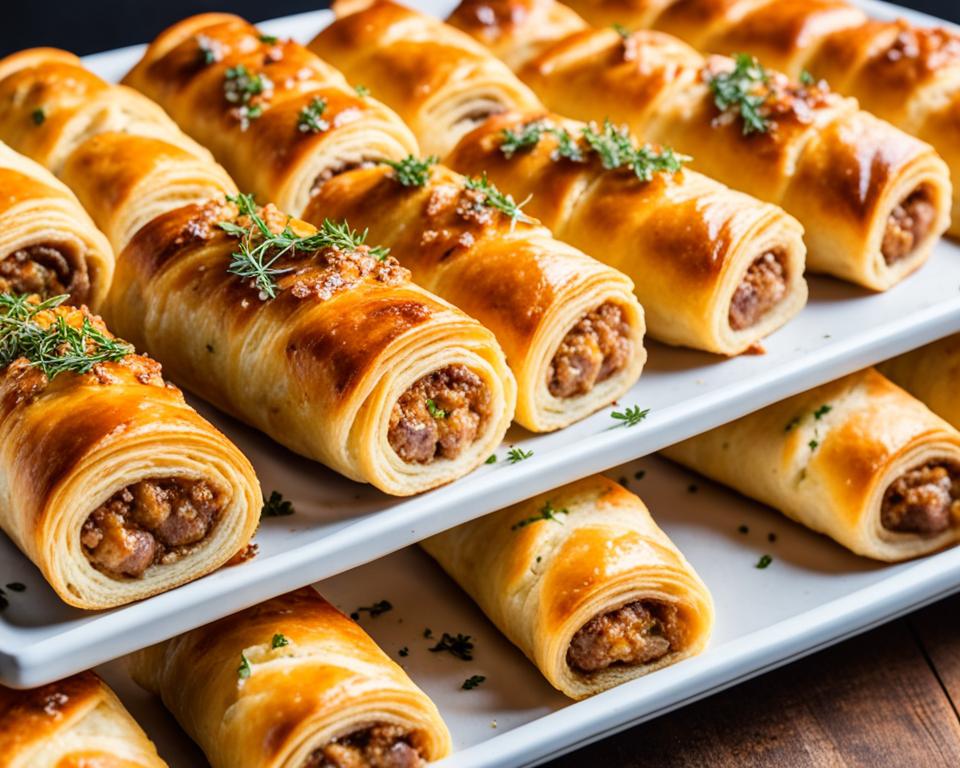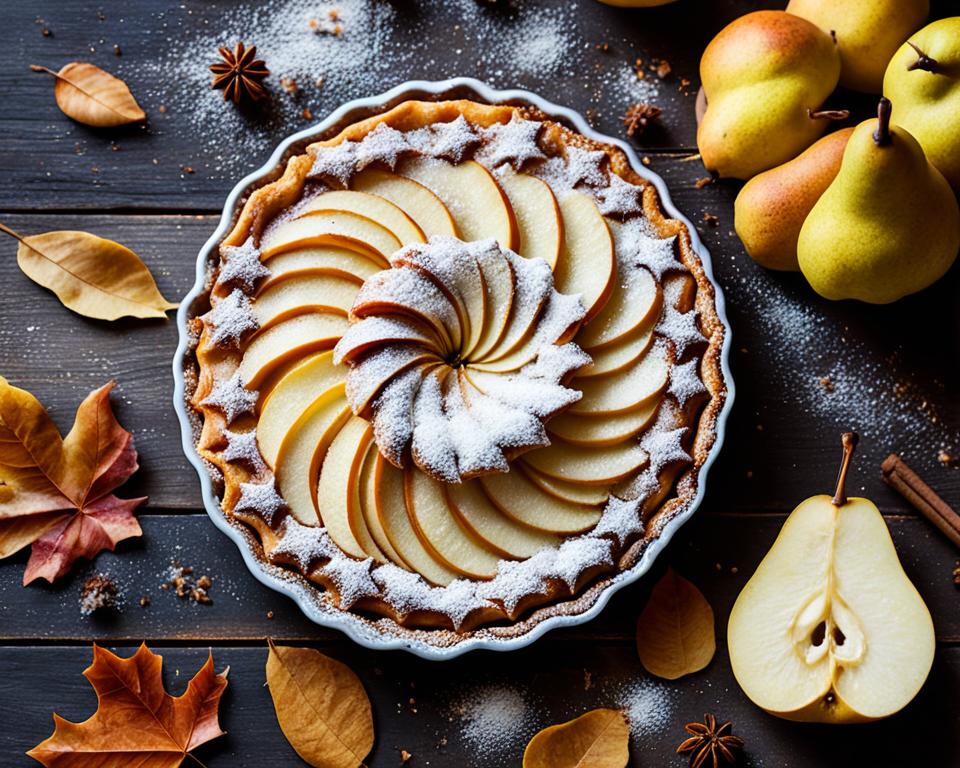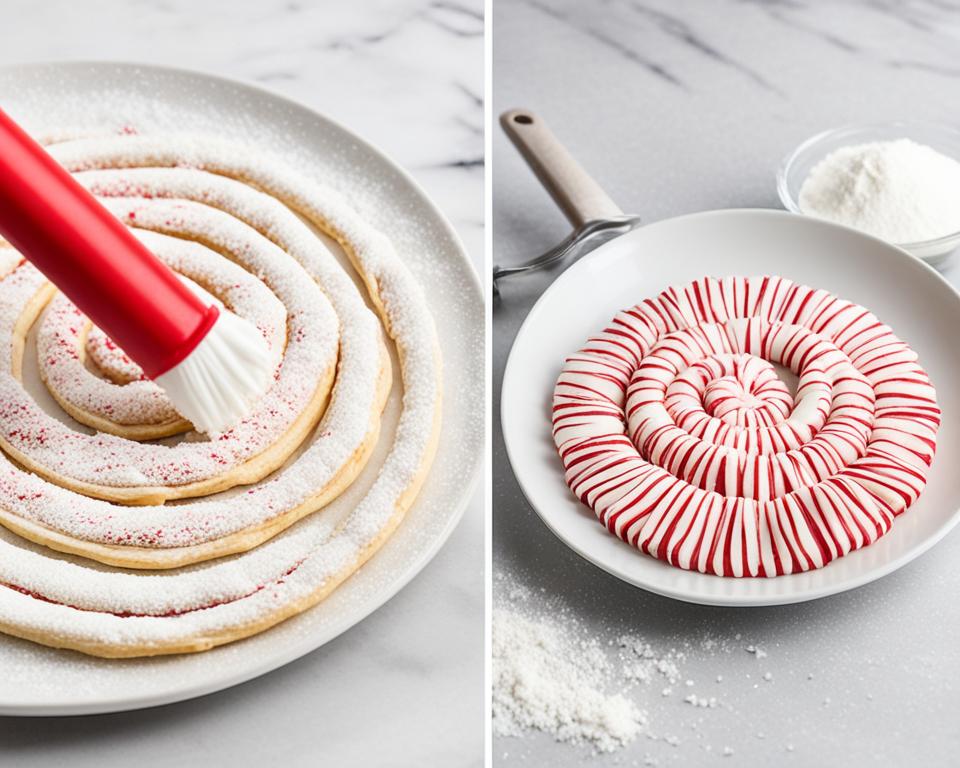Creating the perfect flaky savory pastry at home transforms everyday baking into a gourmet experience. With a few expert tips and the right ingredients, crafting a buttery, flaky savory pie crust is not only possible, but also deeply satisfying. These homemade pastry doughs are not just the backbone of pies and quiches, but are also the canvas for a variety of gourmet pastry recipes. Let’s delve into the secrets of making a flaky pastry that rivals any professional bakery’s offerings, ensuring your culinary creations are the talk of any gathering.
Key Takeaways
- Achieving perfect flakiness starts with keeping all ingredients, like butter and water, ice-cold.
- Sugar in savory pastry dough enhances browning and texture without adding sweetness.
- Understanding the difference between flaky and biscuity pastries is key to selecting your desired crust.
- Homemade pastry dough allows for customization and a homemade touch that store-bought can’t match.
- The folding and lamination process is pivotal to creating the layered texture of a flaky savory pastry.
- Chilling the dough at various stages is crucial to maintaining the integrity of the pastry.
- Whether using the pastry for sweet or savory applications, the method remains the same for a buttery, flaky texture.
Understanding the Basics of Flaky Savory Pastry
When embarking on the journey to create delicious savory pastries, one must first acknowledge the fundamental dichotomy that defines the base of all such treats—the textural difference between flaky and biscuity pastries. Delineating the two is essential for the aspiring baker aiming to master the art of savory pastry, be it for a mouth-watering quiche or a rich, meat-filled pie.
The allure of flaky pastries lies in their liberating, buttery puff, a testament to larger butter pieces that entrap air and, upon baking, release steam. This steam is the artisan’s brushstroke in the creation of the pastry’s signature layers; an architectural marvel in culinary form. Each roll and fold in the process potentially imbues the pastry with more flakiness, more tender crumbs, promising a sensory delight with each bite.
Conversely, biscuity pastries, like the French classic pâte sucrée, form a homogenous union. Butter, sugar, and flour combine without disparity, giving rise to firm, even textures, prized for their crispness and more subdued layers. This is the bastion of sturdy tart bases and structured pie walls; where uniformity and crunch hold sway.
The pursuit of the buttery flaky pastry starts with a marriage of two key ingredients in just the right proportions—a humble offering of butter and flour. Yet, in this simplicity lies complexity, for not just any pour of flour or chunk of butter will do. One seeks a balance, slightly skewed in favor of richness, to evoke that characteristic puff, which sets flaky pastries apart from their noble cousin, the puff pastry, with its symphony of orderly stratified layers.
Consider the process not just a mixing of components but an orchestrated dance where time steps in as an equal partner. Chilling and meticulous rolling out coalesce to encourage the formation of layers that are the hallmark of every easy puff pastry recipe. It’s a ritual of patience and precision, yielding savory pastry fillings encased in clouds of dough—a juxtaposition of flavors and textures.
Let the table below guide you through the essential contrasts that define flaky and biscuity pastries—their identities, their roles, and their eminent results:
| Pastry Type | Texture | Butter to Flour Ratio | Recommended Use |
|---|---|---|---|
| Flaky Pastry | Airily layered, tender | High butter, lower flour | Fruit pies, Savory turnovers |
| Biscuity Pastry (e.g., pâte sucrée) | Crisp, uniform texture | Lower butter, higher flour | Tarts, structured pie bases |
| Puff Pastry | Delicately stratified, light | Equal amounts of butter and flour | Vol-au-vents, Mille-feuille |
Engage with this simple, yet potentially daunting, venture—the achievement of the perfect savory pastry filling encased in a buttery flaky pastry. Let your kitchen be the stage for a gastronomic ballet, twirling and chilling to a rhythm that unveils an easy puff pastry recipe or a savory pie crust. The results are worth every calculated, cold step: voluptuous layers, a joyous crunch, and a warmth that only home-baked, delicious savory pastries can provide.
Essential Ingredients for the Perfect Savory Pie Crust
To embark on crafting your homemade pastry dough, a foundation of select staple ingredients is essential. Each component serves a specific purpose to achieve that golden, buttery flaky pastry that is the hallmark of a savory pie crust. Approaching this culinary feat begins with understanding the importance of the following key ingredients.
Selecting the Right Flour for Structure
Flour is the skeleton of your savory pie crust, providing structure and stability. For the quintessential homemade pastry dough, all-purpose flour is preferred. Rich in proteins, it strikes a delicate balance between yielding a tender bite while developing enough gluten to maintain the shape and form of your pastry creation.
The Role of Butter: Quality and Temperature
Butter is not merely a flavor enhancer but the very essence of flakiness within your pastry. The secret to those sought-after, indulgent layers lies in the use of high-quality, unsalted butter and its temperature. Keeping the butter ice-cold until the moment it meets the flour ensures it doesn’t blend too soon, setting the stage for those dreamy, flaky layers that characterize a sublime savory pie crust.
Balancing Wet and Dry Ingredients
Just as in life, balance is key in pastry—particularly when combining wet and dry ingredients. The liquid elements, chiefly ice-cold water, are responsible for hydrating the flour. Interestingly, a splash of high-proof alcohol like vodka can provide additional benefits, reducing gluten formation for a more pliable and tender dough. Flawlessly marrying these ingredients affirms the flaky, buttery, and irresistibly delicious qualities of the perfect savory pastry.
Remember that a successful homemade pastry dough isn’t just about following a recipe—it’s a symphony of quality ingredients, precise ratios, and respect for the process that contributes to the mouthwatering experience of a savory pie crust. As your kitchen fills with the aroma of buttery flaky pastry, know that your careful selection of ingredients is what turns a simple dough into a gourmet delight.
The Anatomy of a Homemade Pastry Dough
The process of creating homemade pastry dough is akin to an art form, where the intricate layers of fat and dough intertwine to form the foundation for delicious savory pastries. Each layer contributes to the final product—a buttery, flaky pastry that can elevate any dish. To fully appreciate the exquisite anatomy of homemade pastry dough, let’s explore the interplay between its various elements.
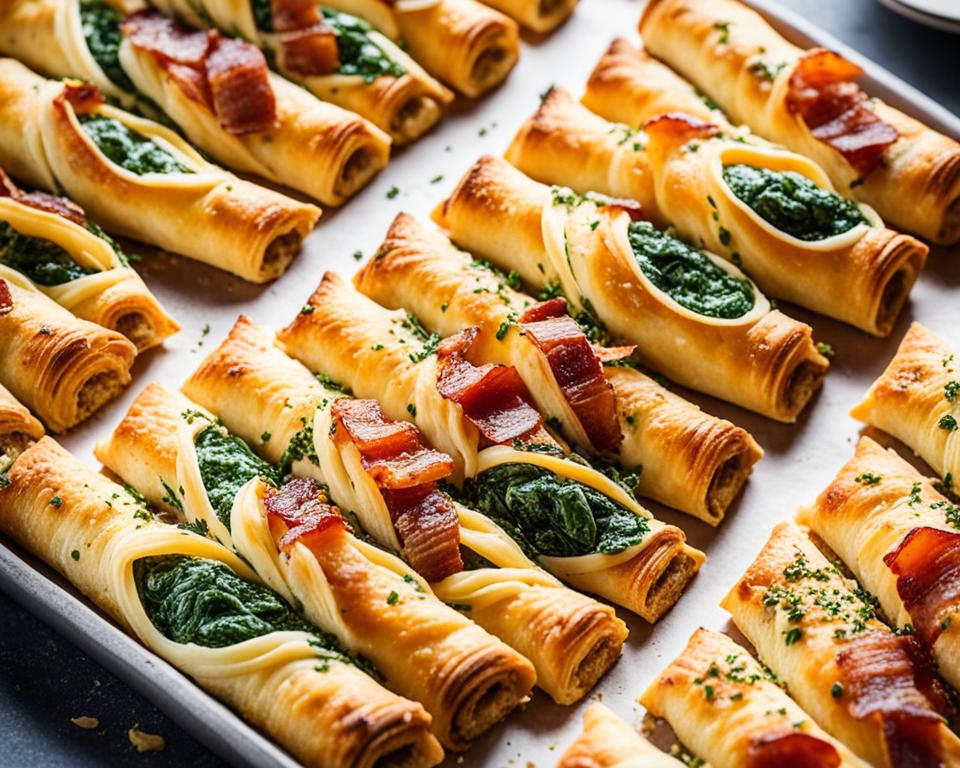
The essential components of homemade pastry dough include carefully sieved flour, precisely measured salt, high-quality unsalted butter, and the requisite amount of cold water. This calculated mixture, when handled correctly, results in an easy puff pastry recipe that brings about the coveted texture of buttery flaky pastry. The key to achieving this lies in the preservation of fat layers within the dough which, when exposed to the heat of an oven, generates steam and inflates the pastry to create its characteristic flaky layers. However, it’s not merely the ingredients themselves but the methodology of incorporating them that truly defines the anatomy of a brilliant pastry dough.
- Chill is the operative word when working with pastry dough. By ensuring all ingredients remain cold, the fat remains distinct and capable of producing steam within the pastry.
- Rest periods in the refrigerator are vital in the creation process, allowing the gluten in the dough to relax and preventing the butter from melting into the flour.
- Rolling and folding the dough are the physical acts that impart layers, a methodical yet gentle approach required to prevent complete blending of butter into the flour.
The rolling and folding technique essential to creating homemade pastry dough can be illustrated in the following table, which outlines the steps necessary to achieve flakiness. Through meticulous preparation and handling, the layers necessary for delicious savory pastries are formed.
| Step | Description | Purpose |
|---|---|---|
| Initial Chill | Refrigerating butter and dry ingredients | Keeps fat solid for layering |
| Dough Formation | Gently incorporating chilled water | Brings dough together without overworking |
| Resting Period | Dough refrigeration before rolling | Relaxes gluten; preserves butter’s form |
| Rolling & Folding | Stretching and layering the dough | Creates flaky layers in the pastry |
| Final Chill | Refrigeration before baking | Ensures butter doesn’t melt prematurely |
Mastery in the kitchen starts with understanding the principles behind each component. As a baker maneuvers through the steps of chilling, folding, and resting, they ensure the success of their culinary endeavors. The result is a homemade pastry dough that stands as the epitome of a buttery flaky pastry, ready to envelop your choice of savory filling with indulgent, airy layers.
Step-by-Step Guide to Buttery Flaky Pastry
Embarking on the creation of a savory pie crust begins with an in-depth understanding of the components and their orchestration. This guide is a pathway to creating that delicious, buttery flaky pastry which sits at the heart of gourmet pastry recipes. A mix of precision, patience, and chilled ingredients is key to achieving the delightful layers characteristic of an easy puff pastry recipe.
Preparing Your Ingredients and Tools
Gather and prepare your ingredients: plain flour, fine sea salt, caster sugar, high-quality unsalted butter, vodka, and ice-cold water. Ensure that all items, particularly fats and liquids, remain cold. In warmer conditions, do not hesitate to place even your bowl and utensils in the fridge or freezer before starting.
Folding Techniques for Maximum Flakiness
To create those sizable butter flakes synonymous with a luxurious savory pie crust, you’ll want to coat your cubed, chilled butter in flour and flatten them. This sets the framework for a dough rich with irregularities, signaling the start of potential flakiness that defines a gourmet pastry recipe. These flat butter pieces, when incorporated into the dough, will translate to airy layers upon baking.
Chilling: A Non-Negotiable Step
A cardinal rule in pastry-making is to chill the dough frequently. Upon forming it into a rectangle, it must be cut, stacked, and rolled. The lamination technique, although simplified here, is pivotal for layering. To preserve the integrity of the butter and consequently the pastry’s structure, regular intervals of chilling are non-negotiable.
The following table illustrates the necessary proportions for a plush savory pie crust.
| Ingredient | Quantity | Purpose |
|---|---|---|
| Plain Flour | 400g | Provides structure |
| Fine Sea Salt | 1 tsp | Enhances flavor |
| Caster Sugar | 2 tbsp | Aids browning without adding sweetness |
| Unsalted Butter | 335g, chilled and diced | Creates flakiness |
| Vodka | 2.5 tbsp | Limits gluten formation for tenderness |
| Ice-cold Water | 8 tbsp | Hydrates without developing too much gluten |
This is the foundation upon which all great savory pie crusts are built. Each ingredient lends itself to a larger purpose, which comes to fruition during baking, resulting in a buttery, flaky, irresistible gourmet pastry. Follow this step by step, and watch the magic unfold in your kitchen.
Rolling Out Your Dough to Perfection
Whether you’re an aspiring home baker or a seasoned culinary artist, achieving the perfect homemade pastry dough is a marrying of craft and science. Once the ingredients are mixed and the dough has been appropriately chilled, the true test of skill presents itself: rolling out the dough to the ideal consistency. The process, though simple in theory, requires a finesse that is vital to the creation of a flaky savory pastry that puffs into layers of rich flavors and textures.
To commence, you’ll first need to ensure that your surface is thoroughly floured. This precautionary step is the first defense against the dough adhering to your workspace—a scenario that can quickly turn your perfect pastry into a frustrating mess. When rolling the dough, aim for a consistent thickness of 6-8 millimeters, a sweet spot that allows for just enough heft to support a savory filling while retaining the delicateness required for a flaky outcome.
Handling the dough with care is paramount. Press and roll with a light, even pressure to avoid overworking the gluten, which could result in a tough, rather than tender, pastry. In this stage, consider the dough to be delicate; it requires a gentle touch to encourage those ethereal layers to form.
Once the dough is rolled, the next phase mimics a lamination technique: A simplified version that serves the home baker well. The dough should be folded and stacked—this action is not a mere repetition, but rather a calculated process that contributes to the flaky layers of your final savory pastry.
Chilling the dough before and after rolling is not a tip to be overlooked. It is, instead, a non-negotiable step in the process of creating a pastry worth its butter. This step ensures the butter remains solid, contributing to the separation of the layers, thus, revealing the magic within a flaky savory pastry once baked.
The table below offers a visual representation of the necessary steps and what each achieves in the creation of that ideal homemade pastry dough:
| Action | Effect on Dough | End Result |
|---|---|---|
| Flour Surface | Prevents sticking during rolling | Smooth, non-torn dough |
| Roll to Consistency | Even thickness throughout | Uniform baking and texture |
| Gentle Handling | Minimizes gluten development | Tender, flaky layers |
| Chilling Pre/Post-Rolling | Keeps butter solid | Defined, puffy layers |
| Folding and Stacking | Introduces layers without complexity | Robust, flaky pastry |
The result of these concerted efforts—a robust, buttery flaky pastry—serves as a testament to the timeless art of baking. While these steps may take practice to perfect, they are undoubtedly worth the effort when considering the final savory delights they promise. Remember, the perfect roll out is not just about the transformation of the dough, but about the assurance that your homemade pastry will stand apart, delighting all who indulge in its flaky layers.
Tips for Achieving Perfect Pastry Lamination
The process of lamination is fundamental in creating that quintessential buttery flaky pastry that serves as a vessel for a delectable savory pastry filling. Mastering this technique can seem intricate, but with a bit of practice, it can become second nature, rendering an easy puff pastry recipe within your baking repertoire. Here we’ll break down the essential steps and tips to ensure your lamination is effective—yielding those dream-worthy layers every time.
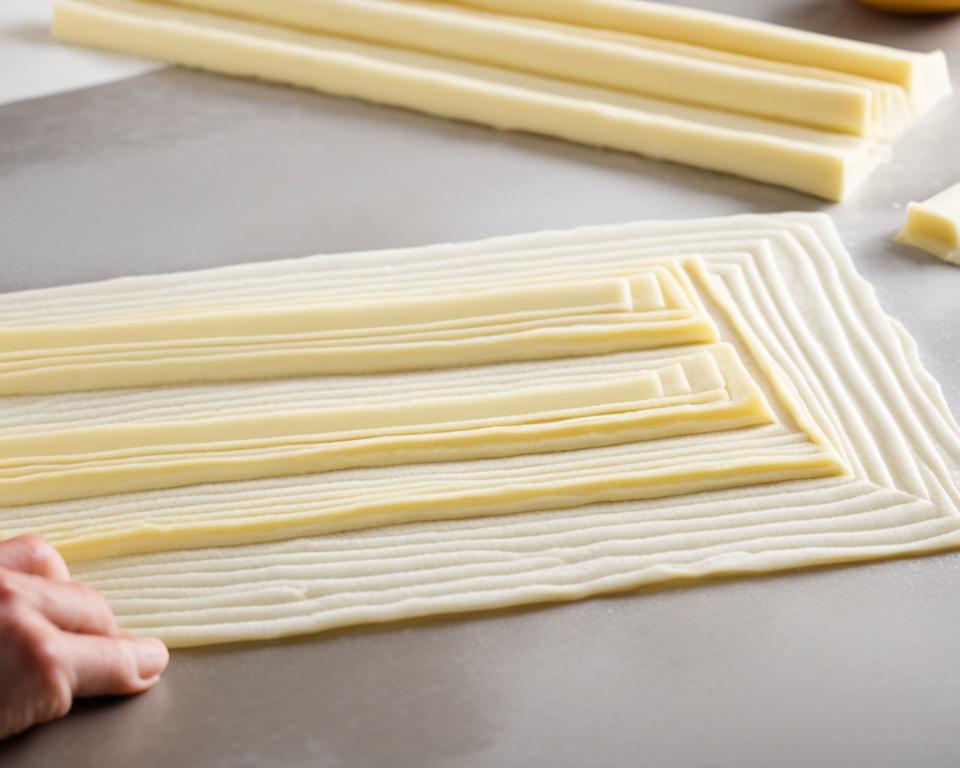
Lamination Explained: Creating Delicate Layers
Lamination is the heart of many gourmet pastry recipes, a technique that meticulously combines fat with dough to construct the light and airy framework of a flaky pastry. The method includes rolling the dough into a rectangle, evenly distributing fat, and folding it in a way that creates concentric layers. This precise ritual is what gifts an easy puff pastry recipe with its characteristic texture.
Keeping it Cool: Managing Dough Temperature
Temperature control is critical when working with pastry dough. Chill is the mantra for mixing, rolling, and folding phases, preventing the butter from losing its form and melding prematurely into the dough. After all, it’s the discrete butter pockets that release steam and elevate the pastry into luscious layers upon baking. By chilling the pastry intermittently during lamination, the dough maintains its integrity, setting you up for a successful savory pie crust.
Handling the Dough: Gentle Yet Effective
Gentle manipulation is the final pillar securing the achievement of delectable, flaky layers in your pastry. A heavy hand can overwork the gluten, stifling the dough’s potential for puff and lightness. Delicate touch paired with intent and understanding of the dough’s behavior underpins the elaborate, seemingly effortless puff inherent to artisanal savory pastries.
- Rest the dough frequently. Allow it to chill in the fridge after each set of folds.
- Use a light touch. Handle the dough and butter with care to avoid compressing the delicate layers you’re trying to create.
- Stay cool. Work in a cool environment to keep butter from melting; consider chilling your utensils and work surface if necessary.
These practices are not just tips but cardinal rules in the quest for the perfect buttery flaky pastry. By adhering to these pointers, even a novice baker can produce savory pastries that puff and entice, rivaling those found in the window displays of the finest patisseries.
The Secret to Making Easy Puff Pastry Recipe
The allure of a delicious savory pastry enveloping a sumptuous filling often lies in its flaky, butter-laden layers—a characteristic that could intimidate even an intrepid home baker. Yet, the mastery of an easy puff pastry recipe is less a guarded secret of seasoned pastry chefs and more about understanding a few fundamental principles of pastry making. The pursuit of the perfect easy puff pastry starts with quality ingredients, a clear method, and the patience to follow through.
One might think achieving the same results as commercial puff pastry requires complicated techniques and specialized equipment, but our simplified approach will guide even novice bakers to create layers of light, airy dough that rival any bakery’s. The quintessential texture of a delicious savory pastry hinge on the visibly separated layers, created through a process that imparts both flavor and structure.
This table exemplifies the relative ease with which one can prepare homemade puff pastry:
| Ingredients | Function |
|---|---|
| Butter | Kept in larger pieces, creates steam and layers when baked |
| Flour | Provides the structure of pastry layers |
| Ice Water | Keeps the dough cool and prevents pre-activation of gluten |
| Cold Environment | Maintains the integrity of the butter for proper lamination |
| Resting | Allows gluten to relax, ensuring tender pastry |
By incorporating the butter in substantial chunks and keeping the dough as cold as possible, we set the foundation for a delicious savory pastry. The traditional turning and folding of conventional puff pastry are replaced with a streamlined lamination technique. Here, dough and butter are rolled and folded more casually, yet intentionally, to keep those precious pockets of fat from integrating into the flour. It’s these pockets, when faced with the oven’s heat, that will expand to create the pastry’s flaky signature.
Each layer, when rolled out and folded correctly, multiplies, resulting in an easy puff pastry recipe that is as delightful to eat as it is beautiful to behold—with a fraction of the effort typically required. By chilling the dough religiously at each step, the butter remains distinct, ready to work its steamy magic in the oven. Bakers must resist the urge to rush and instead allow the cold to play its role.
The methodology is as clear as it is effective—roll, fold, chill, and repeat. With practice and precision, this approach yields flaky savory pastry shells, perfect for everything from classic beef wellingtons to inventive vegetarian tarts. It is the secret pathway to homemade puff pastries that promise to be as buttery, golden, and voluminous as their classical counterparts, ensuring every bite is a tribute to the artisan baker’s skill.
Pairing Savory Pastry Filling with the Right Dough
Embarking on the creation of gourmet pastry recipes requires not just a keen sense of flavor but also an awareness of the symbiotic relationship between pastry dough and its savory filling. The quest to perfect savory pastries demands a harmony of textures and complementary tastes, ensuring that each component elevates the other. When the canvas is a flaky, buttery dough and the masterpiece a rich, hearty savory pastry filling, the balance must be meticulously fine-tuned.
The choice of dough is critical—too delicate, and it may crumble under the weight of a generous filling; too sturdy, and it might overshadow the subtleties of the ingredients encased within. Thus, understanding the strength and texture of your dough is crucial. It serves as both a vessel and a highlight in every bite, helping to transform a simple meal into an extraordinary gourmet pastry experience.
| Filling Type | Dough Selection | Consideration |
|---|---|---|
| Rich, Meaty Filling | Highly Laminated, Flaky Dough | The dough must be sturdy enough to hold the filling while preserving its flakiness. |
| Light, Vegetable-Based Mixture | Slightly Less Laminated Dough | A balance between flakiness and density ensures that flavors are complemented without overpowering. |
For those culinary adventurers crafting savory pastry fillings, the shared journey of dough and filling begins long before they meet the oven’s heat. The butter content, the exactness of lamination, and the appropriateness of the dough’s consistency are all elements that must be factored into the decision-making process.
To guide the home baker in this fine art of pairing, consider the following principles:
- For robust fillings like stewed meats or rich cheeses, opt for a dough with higher butter content to ensure the pastry remains flaky and indulgent.
- When working with lighter fillings such as spinach and feta or roasted vegetables, a less buttery dough may suffice, allowing the subtle flavors to shine.
- The lamination of the dough must align with the desired end texture—numerous thin layers for airiness, fewer for a more rustic, hearty attribute.
The oven becomes the final arbiter, where the union of pastry and filling coalesces into a dish greater than the sum of its parts. With each roll, fold, and ingredient choice, bakers orchestrate a sensory concerto—an ensemble of flavors encased in a golden symphony of flaky layers. Every gourmet creation tells a story, one in which the perfect coupling of dough and savory pastry filling delivers a narrative of taste and delight.
Baking Musts: Oven Temperatures and Techniques
Mastering the art of baking a flaky savory pastry requires precision, especially when it comes to oven temperatures and techniques. To commence the best bake, the oven should be preheated to a high temperature, providing the initial blast of heat needed for the dough to puff up rapidly. This contributes to setting the structure of the savory pie crust quickly, which is crucial in avoiding a soggy outcome.
It is equally important to position the pastry correctly within the oven. By placing a pie on a preheated baking sheet, the bottom receives direct, intense heat upon entering the oven—a strategic move to prevent an undercooked, damp crust. Furthermore, baking your masterpiece on the lower shelf positions it near the heat source, reinforcing the fight against sogginess and ensuring a firm bottom.
An understanding of when to blind bake the crust is another element in the baking toolkit. Should your filling be particularly wet, a pre-bake of the pastry can offset excess moisture, keeping the end result crisp and divine. Regardless of the various timings and specifics, a golden rule in recognizing a perfectly baked pastry is by its golden brown hue—a visual cue for doneness and excellently baked layers.
Let this following table be your guide for baking your savory pastry to perfection:
| Technique | Action | Effect on Pastry |
|---|---|---|
| Preheating | Set the oven to a high temperature before baking | Ensures a rapid puff and sets crust structure |
| Oven Positioning | Place on bottom shelf and on preheated baking sheet | Prevents sogginess, helps achieve a sturdy base |
| Blind Baking | Bake crust prior to adding wet filling | Further helps in preventing a wet, undercooked crust |
| Visual Cue | Monitor the color of the pastry | Golden brown indicates the crust is perfectly done |
By following these essential baking musts of oven temperature and techniques, you ensure that your Flaky Savory Pastry is nothing short of exquisite. Serve up savory delights with confidence, knowing your crust will be perfectly puffed and pleasingly golden every time.
Gourmet Pastry Recipes to Try at Home
Exploring gourmet pastry recipes from the comfort of your home can transform an ordinary day into a luxurious culinary experience. Home bakers seeking to advance their baking artisanship are often drawn to the unique challenge and gratification of creating a buttery flaky pastry. The beauty of these recipes lies in the high-quality ingredients and the refinement of technique, each step in the process contributing to the pastry’s delicate layers and indulgent texture.
One of the secrets to success in gourmet pastry recipes is the generous use of butter. The ratio of butter to flour is typically higher than in standard recipes, resulting in a rich taste and exquisite flaky layers that are synonymous with premium pastries. Valued spirits like vodka or bourbon are often added not only for their intriguing flavors but also because they enhance the texture of the pastry by limiting gluten development.
The spectrum of pastries that one can explore is broad and enticing. Beyond the traditional savory pies, home bakers can test their skills with an array of strudels, turnovers, and other delicate confections. Each of these requires a meticulous attention to detail—from the quality and proportion of ingredients to the precision of folding and lamination techniques. Whether you’re crafting a flaky crust for a rich beef wellington or a buttery shell for a vegetarian pot pie, the principles of creating the perfect savory pastry remain the same.
Here is a comparative table showcasing two gourmet pastry recipes with different levels of complexity:
| Recipe | Complexity | Ingredients | Cooking Time |
|---|---|---|---|
| Classic Beef Wellington | High | Beef tenderloin, mushrooms, mustard, prosciutto, puff pastry | Approximately 2 hours |
| Vegetable Pot Pie | Moderate | Seasonal vegetables, béchamel sauce, herbed pastry crust | Approximately 1 hour |
Embracing the process of creating homemade pastry for these gourmet recipes can be as rewarding as enjoying the final dish itself. As you fold, chill, and roll, you’re not just assembling ingredients; you’re crafting an experience. The aroma of buttery flaky pastry baking is a harbinger of the delightful taste to come—a taste matched only by the sense of pride and accomplishment achieved when the pastry leaves the oven, golden and ready to serve.
To start your culinary journey, choose one of the gourmet pastry recipes and gather the finest ingredients. Remember, the magic is in the melding of simplicity and sophistication—quality butter, a splash of spirits, and the passion of the baker. This combination ensures that the pastries you create will not just be eaten but remembered and revered by all who partake.
Delicious Savory Pastries from Around the World
Across the globe, an enticing variety of delicious savory pastries grace the tables of many cultures, inviting a communal experience steeped in tradition and flavor. These delectable baked treasures often share foundational pastry techniques, yet they are distinctively set apart by their regional ingredients and unique local spices. Each country has its own interpretation of flaky pastry, turning an easy puff pastry recipe into an international sensation that tantalizes the taste buds and brings people together.
In pursuit of expanding one’s baking prowess and offering an array of delicious savory pastries to guests, acknowledging the diversity of savory pastry applications is essential. Celebrated for their flaky texture and savory fillings, iconic pastries such as turnovers, empanadas, and strudels reflect the culinary customs of their native lands.
| Pastry | Country of Origin | Main Ingredients | Cultural Significance |
|---|---|---|---|
| Empanada | Spain/Latin America | Meat, cheese, vegetables | Portable meal, family gatherings |
| Turnover | France | Fruits, meats, vegetables | Elegant snack or dessert |
| Strudel | Austria | Meat, cheese, apple | Classic dessert, holiday favorite |
Widely referenced within numerous recipe circles, an easy puff pastry recipe is just the beginning of a journey through global tastes. The art of baking flaky savory pastry is not only about satisfying hunger but also about celebrating the unique traditions and stories behind each delicious creation.
- The Spanish empanada, with its rich meat or sweet filling, is a staple during festivals and family feasts, a handheld delight that embodies the zest of its people.
- France’s elegant turnovers often appear in patisserie windows, tempting passersby with their buttery crust and promise of sweet or savory satisfaction nestled within.
- The Austrian strudel stands as a testament to the finesse in pastry making, its cinnamon-scented apple versions being a heartwarming presence at many a winter table.
By exploring these and other global savory pastry recipes, bakers can develop a well-rounded skill set that spans continents and cuisines. The array of textures and tastes that make up this world of pastries highlights the versatility and universal appeal of well-made flaky dough. As we incorporate these time-honored recipes into our baking repertoire, we bring a slice of the world into our kitchens and communities, proving that the love for delicious savory pastries knows no borders.
Storing and Freezing Savory Pastry for Future Use
The key to enjoying savory pastry over a period of time is proper storage and freezing methods. Not only do these techniques preserve the texture and flavor of your pastries, but they also provide the convenience of having readymade pastry on hand for quick and savory creations.
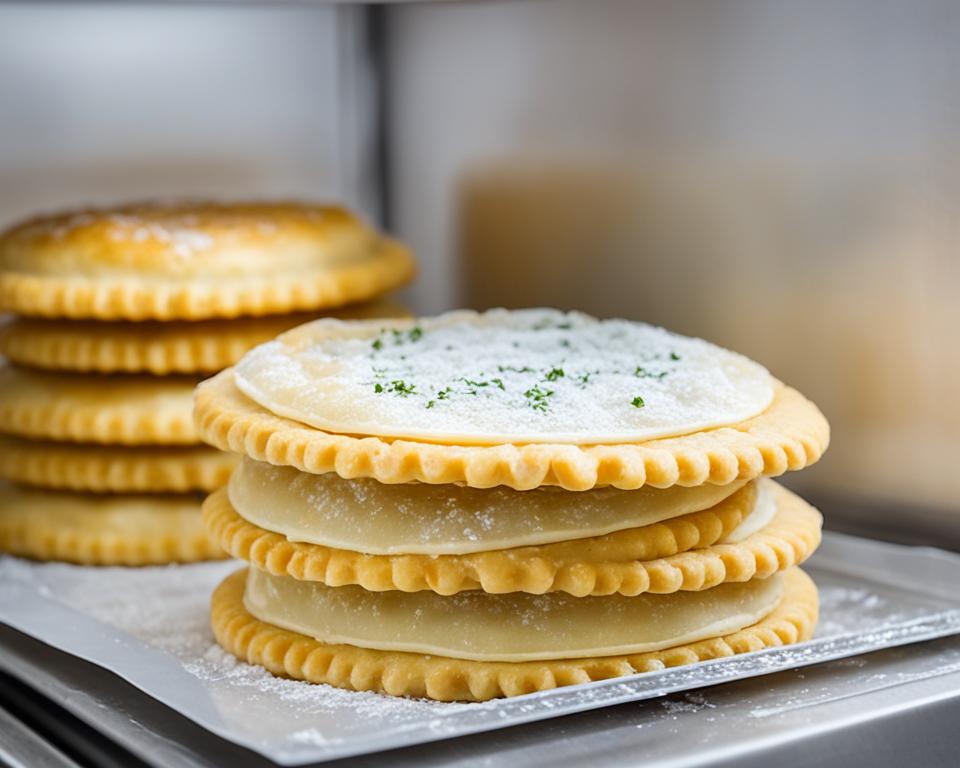
How to Keep Pastry Fresh
Preserving the freshness of savory pastry is paramount for those moments when the craving for a warm, scrumptious pie strikes. By storing savory pastry adequately, it’s possible to maintain that just-baked taste and texture. The refrigerator becomes an ally in this pursuit, wrapping the pastry securely to avoid the drying effects of cold air. Such care extends the life, and delight, of every savory morsel up to 48 hours. Observing the pastry for any color changes, particularly a shift towards gray, is crucial, as this indicates that it’s time to bid farewell to the aging dough.
Freezing Techniques for Long Term Preservation
Freezing savory pastry unlocks the door to prolonged indulgence. Properly enveloped and labeled, frozen pastry shuns the passage of time, waiting patiently for up to six weeks, ready to spring into action when the oven warms. This process of freezing savory pastry offers not just extended enjoyment, but untold efficiency—an invaluable trait, especially during the bustling holiday season.
| Storage Option | Duration | Method | Best For |
|---|---|---|---|
| Refrigeration | Up to 48 hours | Wrap tightly in plastic wrap or aluminum foil | Last-minute meals and quick snacking |
| Freezing | Up to 6 weeks | Wrap in plastic, label, and store in freezer-safe bags or containers | Meal planning and holiday prep |
Whether opting for short-term refrigeration or long-term freezing, the dedication to preserving savory pastry ensures that the fruits of one’s baking labors can be relished over time. Now, every baker can take heart— the pleasure of a flaky, flavorful pastry is never more than a few steps away.
Conclusion
The journey through the art of making flaky savory pastry is one that enlightens the home baker on the intricate dance between cold, butter, and flour. For those who have ventured into the multifaceted world of homemade pastry dough, the rewards are rich—each bite of the prepared dish resonates with the commitment to quality and care taken in the baking process. The versatility of savory pastry filling allows for unparalleled customization, making each pastry a personal testament to the creator’s culinary vision and prowess.
Through mastering the principles of temperature control, the delicate exercises of folding and rolling, and the precise application of baking techniques, the creation of homemade pastries that inspire awe at any dining table is no longer a daunting task but an achievable delight. The layers within these pastries are not just flaky but encapsulate the genuine joy of home baking—an experience that far surpasses the convenience of pre-made doughs.
Aspiring and seasoned bakers alike can find solace in the knowledge that making gourmet-quality savory pastries is well within their grasp. Embracing the process from chilling ingredients to witnessing the pastry take on a golden hue in the oven brings about a unique satisfaction, one that only those who make their pastry from scratch can truly understand. In the realm of savory pastry, the homemade approach undoubtedly reigns supreme, proving time and again to be worth the embrace of home cooks across the United States and beyond.
FAQ
What is the secret to creating a flaky savory pastry?
The secret lies in using cold ingredients and tools, maintaining chunks of butter within the dough, and using proper folding and chilling techniques to create layers that puff up during baking.
Can sugar be added to savory pie crust dough, and if so, why?
Yes, a small amount of sugar can be added to savory pie crust dough. It helps enhance browning during baking without adding sweetness to the pastry.
What is the difference between flaky pastry and puff pastry?
Flaky pastry has a higher butter-to-flour ratio and less even butter layering than puff pastry, resulting in a more robust texture suitable for fruit pies and savory dishes. Puff pastry involves more intricate layering and rolling to create a lighter, crisp texture.
What types of flour are best for making savory pie crust, and why?
All-purpose flour is commonly used for making savory pie crust because it provides the right balance of structure and tenderness, with just enough protein to develop the gluten needed for a flaky texture.
How important is the temperature of ingredients in making homemade pastry dough?
The temperature of ingredients is crucial. Keeping fats and liquids cold ensures that the fat remains in solid chunks, which is critical for creating steam and forming flaky layers during baking.
What are some key folding techniques for achieving maximum flakiness in pastry?
Key folding techniques include flattening butter into the flour, folding the dough to form layers, and not overworking the dough. This helps create the distinct layers necessary for a flaky texture.
What should I consider when pairing savory pastry fillings with dough types?
Consider the consistency and richness of the pastry dough alongside the filling’s texture and flavor. The dough should be flaky yet strong enough to hold the filling, creating a balanced bite.
How do I ensure my baked savory pastry isn’t soggy?
Start by baking at a high temperature, use a pre-heated baking sheet, and place the pie on the bottom shelf of the oven. Consider blind baking the crust if the filling is wet to ensure a crisp crust.
Can I make gourmet pastry recipes at home?
Absolutely! With high-quality ingredients, precision in technique, and frequent practice, you can create gourmet pastries with flaky, buttery crusts in your own kitchen.
Are savory pastries from different cultures made using similar techniques?
Yes, many savory pastries like turnovers, empanadas, and strudels use similar foundational techniques but diversify with regional ingredients and spices.
How long can you store savory pastry, and what is the best way to preserve it?
Savory pastry can be stored in the refrigerator, wrapped, for up to 48 hours. For long-term preservation, it can be well-wrapped and frozen for up to six weeks.

